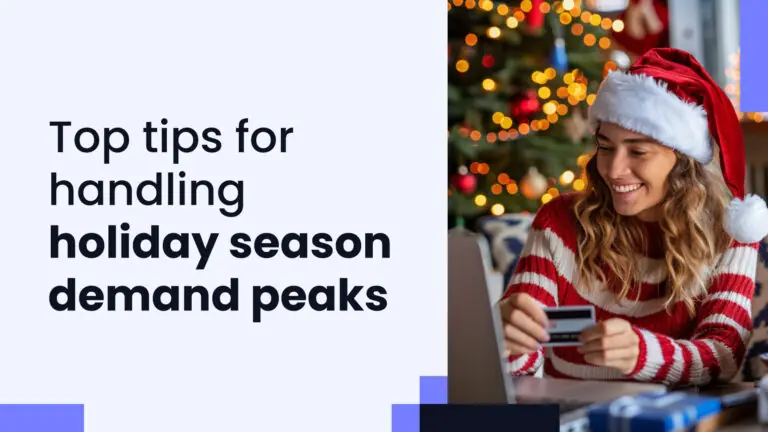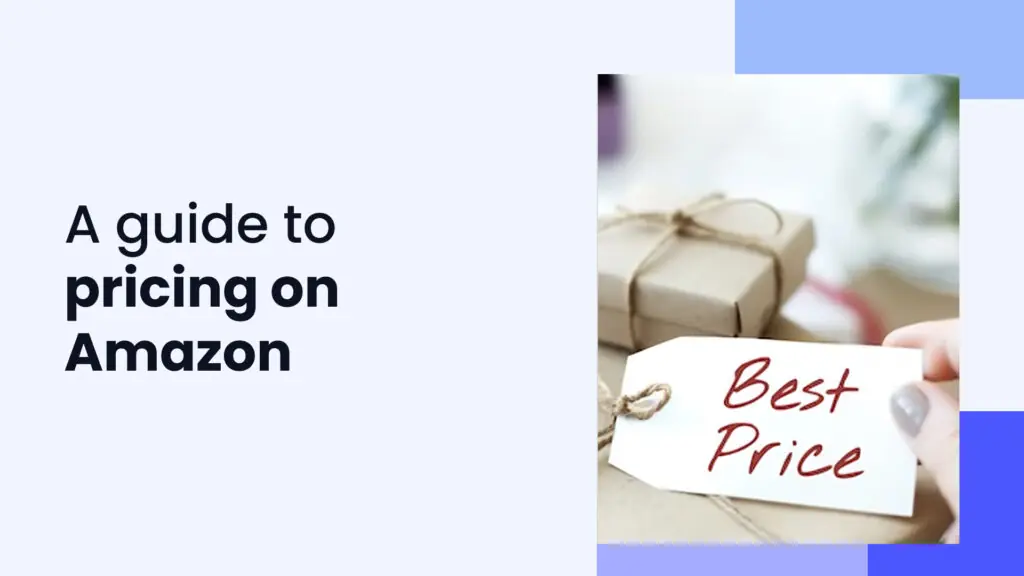When you list a product on Amazon, your ultimate goal is to sell as much as possible and maximize your profits. There are a lot of factors that impact your sales, from product images to optimizing your product title and copy. None of this matters, however, if your product is not priced right.
Pricing on Amazon is crucial for your success as a seller. In order to properly price your product, you’ll have to consider various costs and fees, consumer demand, and the pricing of your competitors. If your price is too high, you will drive away customers searching for a better value. Price too low, and you will eat away at your own profit margin and could even instigate a pricing war with your competitors.
There is no universal formula that you can use to calculate the perfect price for your products on Amazon, but there are some general guidelines and data-backed strategies that you can follow to help you find the best possible price for your listings.
Read on to learn all you need to know about pricing your product on Amazon and how to get the best results for your store.
In this article:
As of 2022, Amazon controlled a whopping 37.8% of the rapidly growing eCommerce market in the United States. That’s six times the share of its closest online competitor.
78% of consumers report that product price is the single most important factor they consider when making purchasing decisions.
With the Amazon marketplace’s terrific ease of entry and massive customer base, competition is fierce, prices are transparent, and customers can move on to other options with the click of a button.
The price of your listings is one of the primary factors which will determine the organic ranking of your products in Amazon’s search results. That’s important, especially when we know that 63% of online shoppers start searching on Amazon.
According to a 2021 survey, 78% of consumers report that they consider product price as the single most important factor to consider when making a purchase. That means that choosing the right price for your product can make or break your sales.
Subscribe to the eCommerce newsletter for
top industry insights
While lowering your price can indeed attract more customers, this strategy may actually hurt your profit margin in the long run. There are a number of factors you should consider when setting the price of your product.
Let’s take a look at the factors you should consider when setting your prices on Amazon. We’ll also learn how to calculate your best price and discuss some tried-and-true pricing strategies you can employ to increase sales and grow your store.
Consumers come back to Amazon again and again for the vast product selection and the convenient shopping experience. For the nearly two-thirds of American adults who pay for a Prime membership, they also come for the fast and free shipping.
With so many products and sellers to choose from, buyers are always looking for the best value for their money. However, it’s important to remember that the lowest-priced option is not always the one with the best value. The data shows that customers know this too. According to a Jungle Scout survey, while the majority of successful sellers on Amazon price their items below $30, more than three quarters of Amazon customers are willing to spend over $100 on a single product.
Clearly, it’s not about selling the most expensive products or undercutting your competitors, but rather about balance.
Before settling on a price for your product, it’s important to take the time to do some research. Find out how much your competitors are charging for similar items. Calculating the average selling price for products like yours gives you a benchmark price for your product.
Once you know this, you can set your price taking into consideration your product costs, profit margins, and other factors. Make sure your price isn’t significantly higher or significantly lower than your competitors, or it can harm your Amazon ranking and sales.
If your product price is significantly higher or significantly lower than your competitors, it can harm both your sales and your Amazon ranking.
It’s often a good idea to avoid pricing your product higher than the average price of your competitors, because if you do, customers can simply find a lower price elsewhere. However, if you can justify the higher price due to the quality of your product or a unique feature that sets it apart, you can price your product higher than this value as well.
Before setting the price of your item, you need to understand all of the costs that go into your product. These will vary greatly depending on your specific products and business model, but may include:
When you know how much money goes into your product, you can make sure to price your item high enough to cover them. Then, it’s time to figure out your profit margin.
Your break-even price is the price point at which the sale of your product covers all of the costs involved in producing and selling it. You won’t make a profit, but you won’t take a loss, either.
Your break-even price is the absolute minimum you can sell your product for without losing money. This is an important piece of knowledge when determining your ideal product price.
Add up all of the fixed costs and variable costs that go into selling each individual product including sourcing, production, freight, warehousing, Amazon fees, shipping, and more. This value is your break-even price.
Your break-even price is the absolute minimum you can sell your product for without incurring a loss. This is a helpful piece of information when you’re figuring out how to price your product on Amazon.
Profit margin is the percentage of your total revenue that you get to keep after paying all the expenses associated with your store. For example, the cost of goods sold (COGS), shipping, advertising, Amazon referral fees, and FBA fees will all be subtracted from your revenue in order to determine your profits earned.
Profit margin can be calculated as a percentage using the following formula:
((Your Sales Revenue – Total Expenses) ÷ Sales Revenue) x 100 = Profit Margin
When setting a price for your product on Amazon, it’s important to take your profit margin into account. Make sure you’re keeping the price high enough to bring in a significant profit margin.
While the ideal profit margin varies depending on your product and goals, it’s often wise to aim for a profit margin of about 25% to 30% for private label products. If your margins are lower than this at first while you’re getting your product off the ground, that’s okay too.
Your base product price is the first value customers see when viewing your listing, but it is not the final price they will pay. The total cost of your product (before taxes) includes shipping and handling as well as any applicable discounts, promotions, or rebates.
This final price is the one that Amazon looks at when allocating awards to sellers, such as the coveted Amazon “Buy Box”. This is the white box on the side of your listing where customers click “Add to Cart” or “Buy Now”. It will also have an impact on where your listing ranks in Amazon’s organic search results, so it’s important to keep this number in mind.
Might also interest you:
There is a wide variety of pricing strategies you can use for your Amazon listings that have all proven successful for different sellers. The best strategy for you will depend on the product you are selling, your costs, changing demand, and of course, your results.
No matter which pricing method you employ, there is one thing to keep in mind: you make sales when you provide value to your customer. Whether through your superior listing, a unique product, an attractive price point, or some combination of these (and of course, your good reviews), your customers need to feel that they are getting a great value for their money when they choose your product.
If you are a new seller or are adding new products to your store, you might want to start off with more competitive pricing. After all, customers feel they are taking more of a risk when buying products with few or no reviews. Try a starting price a bit below that of your lowest-priced competitor. You can then gradually raise your price once you’ve earned some good reviews and built up customer confidence in the quality of your product. However, pay attention to your profit margins and be sure not to set your prices too low.
This technique has a risk of triggering a pricing war among your competitors and devaluing your product. Competitive price cutting is a serious concern among Amazon sellers, and the end result is detrimental to all sellers in your product niche.
As always, it is important to track the prices of your competitors over time, both to determine the viability of your product before entering the market and to ensure that you are listing your product at a realistic and competitive price.
Also known as a split test, an A/B price test can be a fantastic way to see whether your product would sell better (or bring in more profits) at a different price point. This method allows you to make informed choices on your pricing based on data that is unique to your listing.
To run an A/B price test, simply list your product for a predetermined amount of time at two different prices. At the end of both tests, compare the listing’s performance at the two price points you chose. Remember to compare not only how many sales you made, but also your net profit. You may find that even if your sales numbers go down slightly as a result of raising your price, the price increase may be enough to offset the lower sales numbers, increasing your margins and maximizing profitability.
Charm pricing is one of many tried-and-true psychological pricing strategies, and it is probably the simplest one to utilize on your Amazon listings.
This technique is designed to make the customer perceive the price of an item as being lower than it is. Since we read from left to right, a price that ends in a 9 or a 5, such as $6.99 or $6.95 looks like a better deal than $7.00, even if the difference is only one cent. We may think we are too smart to be fooled by charm prices, but studies have shown that this strategy really works.
If you are selling a more expensive item, you might try reducing the price by a full dollar to make it appear more enticing to consumers. For example, if your current price is $500, try setting the price back to $499, and see how your sales numbers respond.
While Amazon Prime members always receive free shipping on Prime-eligible products, non-members pay shipping costs on certain items.
Customers don’t like paying for invisible services, especially when they can get them elsewhere for free. That additional $5 or $10 shipping cost can be a major purchase deterrent. Therefore, offering free shipping can be a great way to boost sales, even if it means pricing your product slightly higher than you would have otherwise.
Thanks to marketing psychology, customers often feel that they’re getting a better deal when they see a discount or promotion, even when the cost of the product isn’t significantly lower.
Use promotions to increase sales without lowering your profits. Raise your price slightly, and then add a coupon or discount. Customers will still feel like they’re getting a great deal.
If you want to entice customers without discounting your product too much, simply raise your price slightly, and then add the coupon to the listing. Your customers will still feel like they’re getting a good deal, and you won’t have to see your revenue take a hit.
A simple way to run a promotion on Amazon is by using the coupon feature. When you add a coupon to your listing, customers browsing through the keyword search results will see an eye-catching coupon offer right under your price. This enticing feature can send more customers to your listing, increasing your click-through rate and conversions.
There are some other psychological pricing strategies you may want to try out, too. For example, play off of customers’ fear of missing out by creating a limited time promotion. Customers will be more motivated to make their purchase quickly so they don’t lose out on a good deal.
Setting one price and leaving it alone is not the best strategy for all sellers. Some Amazon sellers prefer to reprice their products frequently in order to keep up with a changing market. Here are two ways to do this.
If you prefer to leave the complex process of pricing and repricing your Amazon listings up to an algorithm, dynamic pricing may be for you. Amazon is a true pioneer in dynamic pricing and has been using this pricing model for certain products since the year 2000. Today, over 250 million price changes are made on Amazon each day, with the average product’s price changing once every ten minutes.
With this pricing strategy, Amazon uses artificial intelligence and machine learning to constantly adjust your prices, keeping them in line with market dynamics. The program takes into account supply, demand, and the activity of your competition. When the market is busy, your price may change frequently. This strategy can maximize your revenue by helping you convert traffic to sales at a higher rate. While there can also be disadvantages to handing over control of your pricing, you can set a minimum price in this model so that there will be no risk of making sales at a loss.
Dynamic pricing is a built-in feature which is free to use for sellers with a professional selling plan. However, if you do not have this type of account or do not find the features of Amazon’s dynamic pricing tool to your liking, there are many other repricers on the market designed specifically for use on Amazon.
Perhaps you’re intrigued by the possibility of automated repricing – imagine all the time and effort you could save – but you want more control over your pricing model. If you’ve been in the game long enough to know how and when you want your prices to change, rule-based repricing might just be the solution for you.
With this pricing method, you make the rules. You can use a number of factors to determine your prices including the cost of your products, competitor pricing, and seasonality. Your price will automatically change throughout the day based on the parameters you choose, and you can simply monitor the results at your convenience.
You should feel fairly confident in your knowledge of your specific product niche and the Amazon marketplace before using rule-based pricing. You will need to have a good understanding of your costs, your market, and your customers in order to create a set of rules which will work in harmony together. This will ensure that your prices are working to your advantage and optimizing your profit margins.
Have article ideas, requests, or collaboration proposals? Reach out to us at editor@8fig.co – we’d love to hear from you.
Subscribe to the eCommerce newsletter for
top industry insights

Stuck with extra inventory after Amazon’s Spring Sale? Learn five smart strategies to clear unsold stock, boost cash flow, and avoid future overstocks with smarter inventory planning.
![BFCM: The ultimate guide to eCommerce sales [2025]](https://www.8fig.co/wp-content/uploads/2023/09/cover-2-768x432.jpg.webp)
Get ready for Black Friday and Cyber Monday with our guide on maximizing sales through smart inventory management, effective marketing strategies, and leveraging eCommerce financing.

The holiday rush brings with it many challenges for eCommerce sellers. Get ahead of the competition with these top tips.
